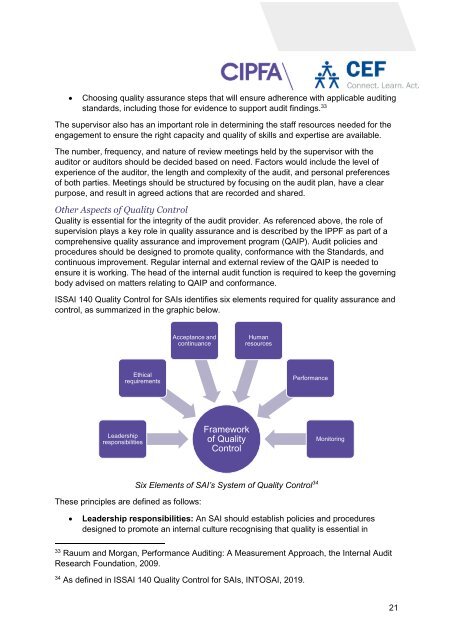Create successful ePaper yourself
Turn your PDF publications into a flip-book with our unique Google optimized e-Paper software.
Choosing quality assurance steps that will ensure adherence with applicable auditing<br />
standards, including those for evidence <strong>to</strong> support audit findings. 33<br />
The supervisor also has an important role in determining the staff resources needed for the<br />
engagement <strong>to</strong> ensure the right capacity and quality of skills and expertise are available.<br />
The number, frequency, and nature of review meetings held by the supervisor with the<br />
audi<strong>to</strong>r or audi<strong>to</strong>rs should be decided based on need. Fac<strong>to</strong>rs would include the level of<br />
experience of the audi<strong>to</strong>r, the length and complexity of the audit, and personal preferences<br />
of both parties. Meetings should be structured by focusing on the audit plan, have a clear<br />
purpose, and result in agreed actions that are recorded and shared.<br />
Other Aspects of Quality Control<br />
Quality is essential for the integrity of the audit provider. As referenced above, the role of<br />
supervision plays a key role in quality assurance and is described by the IPPF as part of a<br />
comprehensive quality assurance and improvement program (QAIP). <strong>Audit</strong> policies and<br />
procedures should be designed <strong>to</strong> promote quality, conformance with the Standards, and<br />
continuous improvement. Regular internal and external review of the QAIP is needed <strong>to</strong><br />
ensure it is working. The head of the internal audit function is required <strong>to</strong> keep the governing<br />
body advised on matters relating <strong>to</strong> QAIP and conformance.<br />
ISSAI 140 Quality Control for SAIs identifies six elements required for quality assurance and<br />
control, as summarized in the graphic below.<br />
Acceptance and<br />
continuance<br />
Human<br />
resources<br />
Ethical<br />
requirements<br />
<strong>Performance</strong><br />
Leadership<br />
responsibilities<br />
Framework<br />
of Quality<br />
Control<br />
Moni<strong>to</strong>ring<br />
These principles are defined as follows:<br />
Six Elements of SAI’s System of Quality Control 34<br />
<br />
Leadership responsibilities: An SAI should establish policies and procedures<br />
designed <strong>to</strong> promote an internal culture recognising that quality is essential in<br />
33<br />
Rauum and Morgan, <strong>Performance</strong> <strong>Audit</strong>ing: A Measurement Approach, the Internal <strong>Audit</strong><br />
Research Foundation, 2009.<br />
34<br />
As defined in ISSAI 140 Quality Control for SAIs, INTOSAI, 2019.<br />
21
















